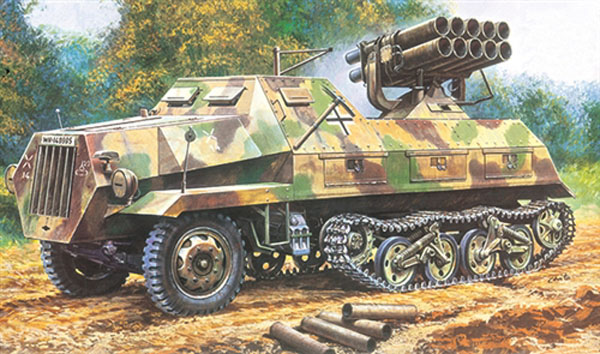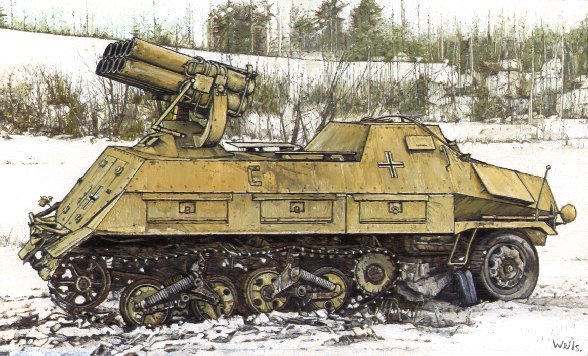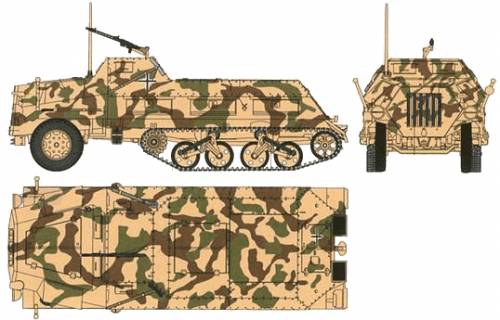


Sd.Kfz. 4-1 15cm Panzerwerfer 42 auf Selbstfahrlafette Maultier Saumur
English Translation
 |
Historique Voir ICI
History Click HERE
Panzerwerfer is the name for two different types of MLRS used Germany during WW 2. The two self-propelled artillery vehicles are
15cm Panzerwerfer 42 auf Selbstfahrlafette Sd.Kfz.4/1 (based on the Opel Maultier, or "mule", half-track)
 |
15cm Panzerwerfer 42 auf Schwerer Wehrmachtsschlepper (or Panzerwerfer auf SWS).
.png) |
Panzerwerfers had a machinegun mounted above the cab. It was known as the "Moaning Minnie" by Allied soldiers for the distinctive noise the rockets made when fired, similar to the Nebewerfer.
15cm Panzerwerfer 42 auf Selbstfahrlafette Sd.Kfz.4/1
Panzerwerfer 42 auf Maultier, Sd.Kfz. 4/1, first went into production in April of 1943, and was produced until March of 1945.
Hitler called for production of the vehicle in January of 1942, and the vehicle saw it’s first tests on the front in fall of 1943.
This device was on a chassis referred to as "Maultier", "Mule". and is referred to with the suffix "42", but all of the German texts about the vehicle refer to it as the Panzerwerfer 43, (first year of production
Opel was the main manufacturer, producing most of the components, including the 3.6 liter, 6 cylinder Adam Opel engine, which had 68 HP and an 80 liter fuel capacity,
 |
During the three years it was produced, 300 Panzerwerfers and 289 of it’s variant, the Munitionkraftswagen, were made (same vehicle, just without the rocket launcher. It was mainly used for ammo re-supply.
Panzerwerfer had a 150-millimeter, 10-barrel rocket launcher, which traversed 270 degrees, could be elevated up to 80 degrees, and was guided with the RA35 optical sight. It had a crew of three, a commander, who was also the driver, a radio operator, and a gunner. During years of production
we found change in armoring and suspension, along with small changes in the shape and thickness of the steel armor, resulting in three specific variants of the vehicle.
150mm launcher was not the only rocket launcher mounted on the Maultier chassis. The 24 rail Vielfachwerfer, (MLRS), was also mounted on the vehicle. It used the same cupola base as the standard launcher, just with a smaller, 80mm launcher.
But this version was used by SS Werfer units, and not the Wehrmacht Werfer battalions.SS Werfer Brigade 506, who was equipped with 24 rail Vielfachwerfers, and we found also some mounted on French halftrack chassis similar in shape and armoring to the Opel Maultier armored halftrack.
Panzerwerfer was saw in Russia in late 1943. The participation at Kursk was no sure There is some evidence that some early launcher prototypes were field tested in battles near Kursk, but that is based only on a few written accounts, and there are no photos
The rocket launcher was used for larger scale rocket barrages against positions of Russian resistance where a large bombardment of a big area would be more effective than more accurate artillery fire. The Panzerwerfer’s rocket barrages covered much larger areas and added more psychological elements to the fight: the amount of noise, smoke, shrapnel, and flying debris as the rockets hit and exploded was tremendous.
He raise on the western front as well. on May 14, 1944, in France
The British and Canadians were the first of the western Allies to see the German rocket launchers in action against troop concentrations and Allied positions. The 7th Werfer Brigade was sent to Normandy from Beauvais after D-Day, and on June 10 it was in Falaise. The next day, the unit was about 10 kilometers from Caen. The unit was part of the attack on the Orne Bridge, which was a British held position over the Orne River. The 84th Regiment of the brigade, which was made up of the 83rd and 84th Regiments, had fourteen combat ready Panzerwerfers, and the 83rd had about the same. Some other Werfer units were the 101st SS Werfer Abteilung, 101st Stellungs-Werfer Regiment, and the SS Werfer Abteilung 102, which was part of the 2nd SS Panzer Division, Das Reich.in France
The rockets the launcher used had only one disadvantage, which was range. The effective range for a Panzerwerfer’s rockets was about 4,000-6,500 meters, and the maximum range was less than 7,000. In Normandy, it was an example of the ineffectiveness of a massed bombardment weapon. A large portion of the salvos fired at troop concentrations missed their mark by hundreds or thousands of feet. The metal rocket casings were thin, which created a large amount of shrapnel on impact, but due to the thin metal used the shrapnel effect was not as deadly as it was intented to be. The weapon caused more chaos than mass casualties. Combat tactics usually called for a group of three to six vehicles to mass fire on a specified position, but on many occassions crews operated from different locations but within the same firing range to reach a predetermined target. Very few Panzerwerfers that were captured by the Allies were captured in any quantity. Photographs of the vehicles taken my German PK (propaganda) photographers generally showed groups of vehicles at staging areas, usually loading the launchers with rockets in preparation for an attack.France.
Most Panzerwerfers were destroyed on the Eastern Front, and American and British units captured or destroyed many of them during Operation Overlord and during Operation Cobra. A few were captured in the last months of the war in southern Germany by American infantry units who marked them and passed them onto field intelligence units who eventually used the information gathered from them to publish late and post war technical intelligence manuals on
Today whe found a fex Panzerwerfer in museum
The best example of one is at the Saumur restored to running condition, with most of its original interior and exterior parts intact, including the 15cm Nebelwerfer 41 rocket launcher. Its tires are about the only post war part of the vehicle, being of British manufacture, leading to the belief that this vehicle was captured by the British, who after capturing it installed new tires, possibly for transport.
Turrrett 15cm Nebelwerfer 41 rocket launcher in Koblenz
.jpg) |
.jpg) |
.jpg) |
.jpg) |
.jpg) |
.jpg) |
| Merci à Vincent |
Voir Aussi Autres Photoscopes See Also Others Walk Around
15 cm Nebelwerfer 41
21 cm Nebelwerfer 43
28 cm Wurfkörper Spreng
schwere Wurfgerät 40 (sWg40)
schwere Wurfgerät 41 (sWg41)
Raketen 15 cm Nebelwerfer 41